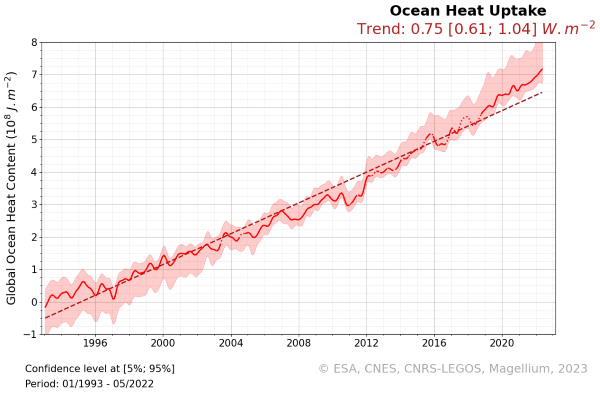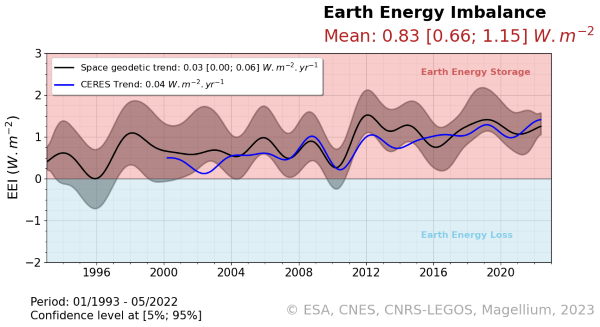Ocean heat content change and Earth energy imbalance: climate indicators from space
Over the past decades, anthropogenic emissions of greenhouse gases (GHG) in the atmosphere have reduced the energy emitted by Earth toward space. Now the Earth emits less energy towards space than it receives energy from the sun leading to a radiative imbalance at the Top Of the Atmosphere (TOA). This energy imbalance called EEI (for Earth Energy Imbalance) is responsible for the accumulation of heat in the climate system making it the primary cause for climate change. It is absolutely essential to monitor EEI to evaluate the amount of energy that is accumulating in the system and to understand how this energy changes the climate.
Measuring the EEI is challenging because it is a globally integrated variable whose variations are small (0.5-1 W.m−2) compared to the typical annual and year-to-year variations of the energy fluxes in and out of the climate system (incoming solar radiation is about 340 W.m−2). Ideally, we would need EEI estimates with an accuracy around ±0.1 W.m−2 at decadal time scales to be able to monitor not only the EEI variations caused by GHG emissions but also the variations in EEI caused by volcanic eruptions or internal variability (such as the Hiatus). This objective pushes the challenge further.
EEI can be estimated by an inventory of heat changes in the different reservoirs of the climate system - namely the atmosphere, the land, the cryosphere and the ocean. As the ocean concentrates the vast majority of the excess of energy (~91%) in the form of heat, global variations in Ocean Heat Content (OHC) place a strong constraint on the EEI estimate.
From the Ocean Heat Uptake...
The OHC change can be estimated directly from net ocean surface heat fluxes measured based on CERES space measurements, from in situ data observed by the ARGO floats or from ocean model reanalyses. We estimate here the OHC change from an alternative method based on spatial altimetry and gravimetry observations which complements these other approaches and which is very promising to reduce uncertainty estimates.
The OHC is estimated from the measurement of the thermal expansion of the ocean based on differences between the total sea-level content derived from altimetry measurements and the mass content derived from gravimetry data, noted “altimetry-gravimetry”.
This space geodetic approach provides consistent spatial and temporal sampling of the ocean. It samples nearly the entire global oceans, except in polar regions where the sea is completely covered by sea ice (i.e. essentially north of 80°N), and it provides estimates of the OHC variations over the ocean’s entire depth.
Contrary to the altimetry data which go back to January 1993, spatial gravimetry was only operational from April 2002. Therefore, the mass content is extended into the past with the use of the mass content from the Climate Change Initiative programme.
The temporal evolution of the global ocean heat uptake retrieved from the “altimetry-gravimetry” space data highlights an increase of +0.75 W.m-2 that corresponds to about 91% of the EEI. The curve is 6-month filtered-out and the envelope error (in light red) is computed at 1-sigma (i.e. at 68% confidence level), and the uncertainty on the slope is computed at 1.65-sigma (i.e. at 90% confidence level) (product version 5.0).
… to an estimate of the Earth energy imbalance
The EEI indicator is derived from the temporal variations of the ocean heat content, i.e. by calculating its derivative (called the ocean heat uptake). Energy uptakes from the land, cryosphere and atmosphere reservoirs represent about 10% of the EEI and are taken into account. The average value of the EEI is +0.83 [0.68; 1.12] W.m-2 (within a 5%-95% confidence range) and shows that on average the Earth stores energy. This EEI value represents an enormous amount of energy when it is integrated into the entire Earth's surface at the top of the atmosphere (20 km) since the EEI represents a total energy uptake of the Earth of about 400 TW (i.e. about 1000 times the power of the world's nuclear power plant).
The temporal evolution of the Earth energy imbalance indicator is approximated by the global ocean heat uptake variations. The global ocean heat uptake was first filtered-out from signals lower than 3 years. The envelope error is computed at 1-sigma (i.e. at 68% confidence level), and the uncertainty on the slope is computed at 1.65-sigma (i.e. at 90% confidence level). The slope corresponds to the acceleration on the ocean heat uptake (product version 5.0).
Results show that on average the Earth stores energy. Clarifying the uncertainties on the EEI indicator will help to address the question: are EEI’s variations significant?
The OHC-EEI product
Users will be mainly interested in:
- global ocean heat content change time series (representative of the globe within the extent of data availability)
- Earth energy imbalance time series (from global OHC filtered-out from signals lower than 3 years)
- the uncertainties associated with these two datasets
All data used to calculate the indicators are given in full transparency. Starting with version V3.0, these intermediate and mainly gridded variables are gathered in the secondary product called "extended product". Thus users can rebuild their own OHC change or EEI indicators.
Product Versions
Consult the table below for the different versions of the OHC-EEI product.
DOI and metadata
This product is referenced with a DOI: 10.24400/527896/a01-2020.003
More metadata: https://commons.datacite.org/doi.org/10.24400/527896/a01-2020.003
Product access and condition of access
The product (NetCDF file) can be downloaded in open acces on the HTTPS server or via the non authenticated FTP download (if the FTP protocol is not supported by your browsers, see this note)
The product is available free of charge for any project or study, and delivered as stated in the licence agreement.
Citation
If you use the data, please cite:
For v1.0: "The OHC/EEI product from space altimetry and space gravimetry was produced by Magellium/LEGOS and distributed by AVISO+ (https://aviso.altimetry.fr) with support from CNES and ESA (https://doi.org/10.24400/527896/a01-2020.003 version XX)"
From v2.1: "The OHC/EEI product from space altimetry and space gravimetry was produced by Magellium/LEGOS and distributed by AVISO+ (https://aviso.altimetry.fr) with support from CNES (https://doi.org/10.24400/527896/a01-2020.003 version XX)"
Contacts
For any technical issues or additional information related to the OHC-EEI product, users are advised to contact Florence Marti (technical coordinator) : florence.marti(at)magellium.fr
Acknowledgment
For v1.0, this work has been supported by ESA in the framework of the MOHeaCAN project (Monitoring Ocean Heat Content and Earth Energy ImbalANce from Space): eo4society.esa.int/projects/moheacan/. For all the versions, this work is also supported by the CNES for the dissemination of the products through ODATIS, and for the future evolutions of this product.
References
Ablain et al., OSTST 2022: Monitoring the Ocean Heat Content change and the Earth Energy Imbalance from Space Altimetry and Gravimetry missions
Ablain, M., Meyssignac, B., Zawadzki, L., Jugier, R., Ribes, A., Spada, G., Benveniste, J., Cazenave, A. and Picot, N. (2019) Uncertainty in satellite estimates of global mean sea-level changes, trend and acceleration, Earth Syst. Sci. Data, 11(3), 1189–1202, doi:10.5194/essd-11-1189-2019, 2019.
Blazquez, A., Meyssignac, B., Lemoine, J., Berthier, E., Ribes, A. and Cazenave, A. (2018) Exploring the uncertainty in GRACE estimates of the mass redistributions at the Earth surface: implications for the global water and sea level budgets, Geophys. J. Int., 215(1), 415–430, doi:10.1093/gji/ggy293, 2018.
Horwath, M., Gutknecht, B. D., Cazenave, A., Palanisamy, H. K., Marti, F., Marzeion, B., Paul, F., Le Bris, R., Hogg, A. E., Otosaka, I., Shepherd, A., Döll, P., Cáceres, D., Müller Schmied, H., Johannessen, J. A., Nilsen, J. E. Ø., Raj, R. P., Forsberg, R., Sandberg Sørensen, L., Barletta, V. R., Simonsen, S. B., Knudsen, P., Andersen, O. B., Ranndal, H., Rose, S. K., Merchant, C. J., Macintosh, C. R., von Schuckmann, K., Novotny, K., Groh, A., Restano, M., and Benveniste, J.: Global sea-level budget and ocean-mass budget, with a focus on advanced data products and uncertainty characterisation, Earth Syst. Sci. Data, 14, 411–447, doi.org/10.5194/essd-14-411-2022, 2022.
Marti, F., Blazquez, A., Meyssignac, B., Ablain, M., Barnoud, A., Fraudeau, R., Jugier, R., Chenal, J., Larnicol, G., Pfeffer, J., Restano, M., and Benveniste, J.: Monitoring the ocean heat content change and the Earth energy imbalance from space altimetry and space gravimetry, Earth Syst. Sci. Data Discuss., 1–32, doi: 10.5194/essd-2021-220, 2021.
Meyssignac, B., Boyer, T., Zhao, Z., Hakuba, M. Z., Landerer, F. W., Stammer, D., Köhl, A., Kato, S., L’Ecuyer, T., Ablain, M., Abraham, J. P., Blazquez, A., Cazenave, A., Church, J. A., Cowley, R., Cheng, L., Domingues, C. M., Giglio, D., Gouretski, V., Ishii, M., Johnson, G. C., Killick, R. E., Legler, D., Llovel, W., Lyman, J., Palmer, M. D., Piotrowicz, S., Purkey, S. G., Roemmich, D., Roca, R., Savita, A., Schuckmann, K. von, Speich, S., Stephens, G., Wang, G., Wijffels, S. E., Zilberman, N. (2019) Measuring Global Ocean Heat Content to Estimate the Earth Energy Imbalance, Front. Mar. Sci., 6, doi:10.3389/fmars.2019.00432, 2019.
List of the product versions
Name | Version | Publication date | Product characteristics | Documentation | Product access | |||
| Product user manual | Algorithm theoretical basis document | Associated publication | HTTPS | FTP | ||||
| MOHeaCAN global | 1.0 | Dec 2020 | Global ocean 3*3 deg 08/2002-06/2017 Monthly | PUM v1.2 | ATBD v1.2 | - | open access | non authenticated ftp |
| MOHeaCAN global | 2.0 | Apr 2021 | Global ocean 3*3 deg 08/2002-08/2016 Monthly | PUM v1.3 | ATBD v1.3 | - | ||
| MOHeaCAN global | 2.1 | Oct 2021 | Global ocean 3*3 deg 08/2002-08/2016 Monthly | PUM v1.4 | ATBD v1.4 | Marti et al., 2021 | ||
| MOHeaCAN global | 3.0 | Dec 2021 | Global ocean 3*3 deg 08/2002-12/2020 Monthly | PUM v1.5 | ATBD v1.5 | - | ||
| MOHeaCAN global | 4.0 | Oct 2022 | Global ocean 1*1 deg 04/2002-12/2020 Monthly | PUM v1.7 | ATBD v1.7 | - | ||
| MOHeaCAN global extended (contains additional variables | ||||||||
| MOHeaCAN global | 5.0 | Apr 2023 | Global ocean 1*1 deg 01/1993-05/2022 Monthly | PUM v1.8 | ATBD v1.8 | - | ||
| MOHeaCAN global extended (contains additional variables | ||||||||



















